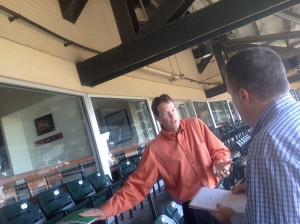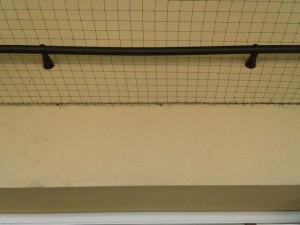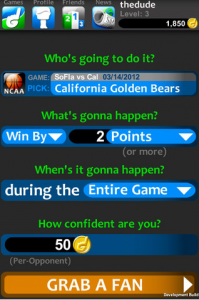It’s fun to look back at the news from 2004 to see just how novel an idea it was to put a Wi-Fi network into a ballpark. “SBC Park a hot spot for fans lugging laptops,” said an article in the San Francisco Chronicle, complete with a photo of a fan hunched over a laptop. According to the story, some 200 fans per game might have used the network right after it was launched. Woo-hoo!
Fast forward to 2012, and here are some eye-popping stats from a recent Giants homestand against the Cubs: According to the Giants and AT&T, at one game there were 10,000 fans using the stadium’s Wi-Fi network, and another 10,000 connecting via the various cellular antennas — all using a data app, not even counting phone calls. Still think this is just something for power geeks trying to program in between innings? Or has the wireless fan finally become mainstream?
As impressive as those totals are, what’s a more compelling story is the fact that the Giants and AT&T were ready for that bandwidth demand, with a layered cellular and Wi-Fi network that overdelivers, instead of dropping connections. Why did they put the network in, and how did they make it a success — and a role model for stadiums and teams everywhere? To get the answer to those questions, Mobile Sports Report recently spent a couple hours at the ballpark with Bill Schlough, senior vice president and chief information officer for the San Francisco Giants Baseball Club, and Terry Stenzel, vice president and general manager for Northern California and Reno for AT&T, to hear about lessons learned and where wireless and sports are headed in the future.
The Super-Connected Fans of San Francisco and Silicon Valley
Back when AT&T was still known as SBC, the ballpark with its name seemed as likely a place as any to put in a wireless network. Though it wasn’t even the first in the Bay area — Candlestick Park, former home of the Giants and still host to the football 49ers, had some limited wireless access back in 2000 thanks to then-stadium-naming sponsor 3Com — the network that went live at the China Basin ballpark in 2004 was well received by the wired constituents of the greater SF Bay area. After all, this was Silicon Valley — where folks didn’t mind going to Best Buy to get a wireless LAN card to put in a PCMCIA slot.
For the Giants and Schlough, every year afterward it became apparent that the initial outlay of 121 Wi-Fi access points wasn’t going to be enough. The 50 bearded guys with laptops from the Valley became a few hundred a night, then pushed into the thousands. By 2010, the network-use number was up to 3,300 per game, with no end in sight to its growth.“I point to the fans” when asked about where the vision for the network comes from, said Schlough. “In any other city it’d probably be different — anywhere else is probably a couple years behind [in network demand]. Fans here are making it apparent that if they can’t stay connected they’re going to stay home. What we need to do is stay one step ahead.”
Lately, that means staying ahead by blending cellular and Wi-Fi networks, using a “layered” approach that improves not only Wi-Fi coverage inside the stadium, but also reception for 2G, 3G and 4G LTE cell phones. It even means reaching out to rival Verizon Wireless, which is in the process of attaching its own wireless services to the Giants’ stadium network, so that Verizon customers can enjoy improved coverage just like AT&T customers do when in their seats. Even with network loads of 20,000 combined users, the Giants and AT&T right now seem like they’re ahead of the technology curve; but even fairly recently, that wasn’t always the case. Take the start of the 2009 season, when the network became, as AT&T’s Stenzel said, “an absolute disaster.”
A Network Brought to its Knees — by Apps and the iPhone
Perhaps fueled by the twin arrivals in 2008 of the iPhone 3G and the accompanying Apple Appstore, the fan demand for in-stadium bandwidth completely overwhelmed the AT&T Park network at the start of the 2009 season, an epic fail that was quickly noticed by many. The surge in wireless data demand — which also caught AT&T by surprise at that year’s South by Southwest Interactive conference, where iPhones and Twitter brought the network in Austin to a halt — was a harbinger of the future, forcing cellular providers everywhere to scramble to upgrade their networks.
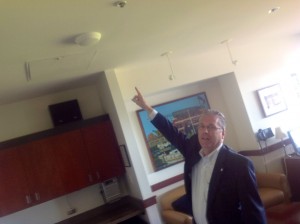
AT&T VP Terry Stenzel points to a Wi-Fi antenna inside a suite at AT&T Park. Credit: John Britton, AT&T.
The DAS antennas help provide what Schlough and Stenzel call their “layered” approach to wireless connectivity, meaning that a blend of Wi-Fi and improved cellular is the best way to achieve the highest level of connectivity. With a layered approach, some fans can use the Wi-Fi network while others use the cellular network — hopefully, using the best signal where it is available.
“The stadium is the perfect example of what’s going on in the outside world,” said AT&T’s Stenzel, whose company of late is investing heavily in both DAS and Wi-Fi for public hotspots in cities, big buildings and campuses to offload some of its cellular-network demand. “You can’t build a network with Wi-Fi only or [4G] LTE only. You need layers of technology.”
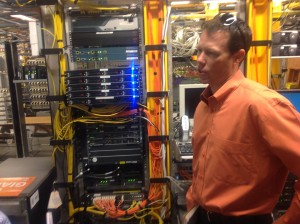
The Giants' Bill Schlough in front of some hard-working wireless network hardware. Credit: John Britton, AT&T.
“Thank god we’re not football,” said Schlough. “This isn’t something that you plug it in and it works. We have 81 games a season here, and every day we’re learning something.”
Trials, Errors, and ‘Leaky Coax’
For Giants fans or even other visitors, Schlough has a wireless quest: “I’d challenge anyone to walk in here and find 100 antennas,” he said. With 334 Wi-Fi access points and 196 additional DAS antennas scattered about that seems like it might be easy. But even certified network geeks probably couldn’t spot the DAS antenna that Schlough said was in plain sight, providing access to the outdoor seats on the suite level.
While your reporter valiantly looked for a telltale wireless box, it was in vain. Schlough finally solved the puzzle by turning us around and pointing at a black-painted conduit pipe just above the seagull net — inside which Schlough said was some leaky coax, or partially unshielded networking cable that allows a signal to pass through parts of its length, in essence acting as a long, thin “antenna.”“You’ve got to get creative” to solve stadium networking problems, said Schlough, whose team needed to point Wi-Fi antennas upward to serve three rows of upper-deck seats that are located in front of a thick concrete wall. In some parts of the stadium, Wi-Fi antennas are painted dark green to match the stadium metalwork. In the suites, Wi-Fi antennas are tucked into plastic housings that look like smoke detectors, and some DAS antennas are inside small inverted plastic cones — all painted the same color as the ceilings to blend in like wireless chameleons.
“The biggest challenge may be in hiding all the wires” connecting the antennas, Stenzel said. “Nobody wants to see wires hanging down in a stadium.”
One App Will Rule Them All — Unless the Giants get to Tinker
Perhaps the only place where Schlough, the Giants and AT&T have had to take a step backwards — our opinion, not theirs — is on the application side. Until last year, the Giants led in the app innovation arena as well, with a service called “Digital Dugout” which provided lots of AT&T-specific information, like park maps, food ordering, and extended Giants video highlights, among other features. But as part of Major League Baseball the Giants are now in lockstep with the rest of the league and only offer MLB.com’s AtBat app as the in-game app of choice — a strategic move made by the league last year to increase the profitability of its flagship online app and service.
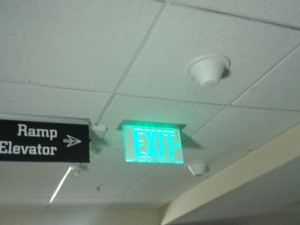
The white inverted cone? A DAS antenna in the AT&T Park suite level hallway. Credit: Paul Kapustka, MSR.
“We’re working with MLB to see if we can add any [local] functionality to AtBat,” Schlough said. “We’re the first team to dip our toes into that water.”
Internally, the Giants have become big wireless users themselves. According to Schlough the team now uses its wireless network to run tasks like ticketing, some concession kiosks, the media needs and digital message boards. That’s probably why the team now has two full network-operation rooms in the bowels of AT&T Park, crammed with every flavor of telecom gear from 2G, 3G and 4G cellular to Wi-Fi controllers and a whole assortment of Internet routers, servers and other associated rack-mounted hardware sporting the logos of companies like Cisco, Juniper, Dell and HP.
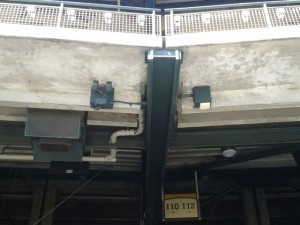
Can you see the Wi-Fi antenna? It's the green box on the left with two tubes. Credit: Paul Kapustka, MSR.
“The most common app we see used at the games is maps,” said Stenzel. “It’s all about, ‘where am I going from here,’ for dinner or drinks. A ballgame is a social event, a fan experience that you’re going to remember.”
As long as you stay — and stay connected, that is.
“Now if the DAS goes down, people leave,” Schlough said. And you get the feeling that he was only half joking.
